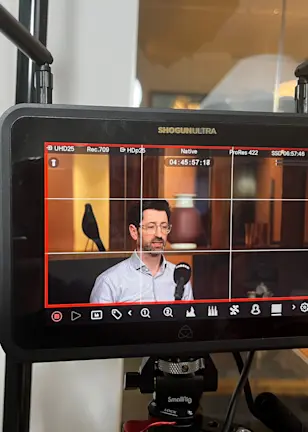Can you describe your work on marine and ocean biodiversity and the governance of fisheries?
“My work has focused on marine ecology and sustainable fisheries, much of it in developing countries, as these tend to be where we in developing nations source our food. I have been studying the value chains and some of the sustainability strategies used by corporates to try and promote more sustainable fisheries. More recently I’ve been working with some of the larger companies through the SeaBOS Initiative (The Seafood Business for Ocean Stewardship).”
“Large corporates are driven by their investors and what they would like to see done. So we look closer at what this means for the 100 largest seafood companies in the world; at their ownership structures, and given that only about half of them are even publicly listed, the kinds of leverage points that are left to work with for investors.”1
Regulations in emerging market value chains can be quite weak. How can we get around this to make the whole system more sustainable?
“This is a difficult question to answer; if it was easy, we would have done it by now. Part of the problem is the complexity in that we are sourcing from small communities operating in largely ungoverned or weakly governed contexts. We now have fisheries improvement projects which work through the supply chains to push sustainability criteria down towards the suppliers in small-scale fishing communities in, for example, the Philippines and Indonesia. But traceability still often breaks down when you have hundreds of small-scale fishermen going out and sourcing – especially when they are not even aware of the sustainability criteria that downstream buyers have. They may understand that they are undermining the resources through unsustainable fishing methods, but these are people who are struggling for their daily livelihoods. Faced with that, you are going to fish down to the last crab, simply because this kind of short-termism is necessary in order to survive.”
“There's also a lot of social pressure in these communities involving status and other things that are not purely contractual. Unfortunately, these all add up to a complex toxic cocktail of unsustainability on the ground. That’s not the case for some of our big fisheries where we can be more effective, as we can ask these companies to sign up to sustainability initiatives. But it's really difficult for these more complex supply chains.”
“Sustainability in fisheries is therefore often going to be related to investments in general community development, to increase educational levels, alleviate poverty and provide viable alternatives to supplement limited fishing opportunities. That is not, perhaps, at the forefront of the minds of corporate investors.”
Much of the problem involves levels of waste, particularly in discarded fish. What can be done about this?
“There has been a big debate about discards because of how complex the technicalities are. You basically need to have the rules in the first place that say discards are not okay, then the ability to actually monitor it. It would be great to have the local Navy out there policing, but many nations don't have the capacity to monitor their waters, and monitoring discards means boarding a vessel or catching them in the act. This is difficult and costly.”
“Another problem with discards is that most of this stuff is not even alive anymore. When it’s dumped overboard, it's already dead and it’s totally wasted. Using discards for something meaningful, like feed, would reduce the waste but at a significant risk of incentivizing more unsustainable fisheries, more by-catch and creating an economic incentive to continue doing what they’re doing.”
You work on a 10-year research project into ‘balancing the environment with economics to inform a transformation of investment practices’. What does that entail?
“It’s broadly about working with banks and investors to promote sustainability from the financial side. Most investors have equity investments where you can engage with the companies, but a lot more can be done on the credit side, where you can engage on a higher level – particularly since 50 of the world’s largest seafood companies are privately owned. And if you are a lender to seafood companies, you can get them to sign up to programs such as the Principles for Investment in Sustainable Wild-Caught Fisheries2, which are modeled on the Equator Principles.”3
“As an investor you will have to recognize that the sustainability challenges these companies face in their particular fisheries will usually be context dependent, whether it's a pelagic fishery (open sea) or a or a demersal fishery (on the floor of the sea or a lake), or something else. Investors can suggest the scientific methods that would be the best way to deal with these issues. Then they can develop KPIs for improvement, and follow up on how they are being implemented. There should also be a due diligence process with a clear and transparent means of reporting on progress.”

On this issue of investor involvement, what should investors be doing more, or less of?
“Exclusions can be used on the equity side, but there's always going to be someone else who picks up that stock, so it's not super powerful from a sustainability perspective. And if you only hold a small amount of shares in each of these companies, as investors tend to do, then I don't see divestment as a forceful way of acting.”
“The credit sector is where the power really lies. You should have a clear process for engaging with the companies in your credit portfolio and asking the right questions, such as what kind of fishing fleets these companies have. It's about making sure that they have KPIs that can answer the challenges in that particular part of the sector. But it’s more difficult here than it is for climate, where we have science-based targets for carbon, but we don't have this kind of thing for fisheries.”
This all requires data. Do you have the same kinds of problems accessing data for fisheries and marine biodiversity as we do for land biodiversity?
“Getting good data is always difficult. As scientists, we don't have any access to company data; generally we're completely reliant on databases from the Food and Agriculture Organization,4 which we know is problematic and at a fairly low resolution. The difference is that an investor can ask its client companies for data and disclosures that they wouldn't necessarily disclose publicly.”
“From a scientific point of view, we've gone through seven primary sectors including fisheries, wild capture and aquaculture, to review what science has documented as the key environmental impacts of these sectors. We have shared this information with the scientists who are the experts on the impact of each of these sectors and asked them to review and vet it. This has resulted in a set of suggested company disclosures that would capture the most essential environmental impacts for the seven sectors, and in doing so allow investors to actually start to get a handle on the ‘state of nature’, the term used in the soon-to-be launched TNFD framework (the Taskforce on Nature-related Financial Disclosures).”5
Keep up with the latest sustainable insights
Join our newsletter to explore the trends shaping SI.
As the oceans become progressively depleted, is aquaculture and business such as salmon farming part of a long-term solution?
“Aquatic foods need to be part of the equation for a sustainable food system. But it is erroneous to think that salmon farming, or the farming of any kind of carnivorous fish, is going to be the solution to our problem. Currently, we are trawling the seas and basically mushing up fish into fishmeal and fish oil, then feeding it to salmon and losing a whole lot of energy in the process. That is just not sustainable. Some of the large aquaculture companies that we have worked with in Norway and Chile would like to think that their products are what's going to save the world, but I don't think so.”
“But certainly we need aquaculture to be part of the mix, because our seas are basically at their limit. That aquaculture will have to be very well set up so that it doesn't have a negative impact on the local environment through effluence and issues like the overuse of antibiotics that just undermine everything. We also need to be careful to avoid losing a lot of protein in the process, because then we have no net gain. We need to farm fish that can eat insect meals mixed with vegetables and other sorts of plant-based feed. Or it could be novel nutrition such as waste from terrestrial animals, where there has been a lot of development in this sector.”
Diets and consumer trends are changing, and millennials are driving organic food demand. Is using the market economy to promote more sustainable food the way forward?
“The problem with sustainability is that no natural commodity can ever be sustainable if everyone wants it. There are boundaries to everything. Even if we make our production systems really efficient, there is a limit beyond which it becomes unsustainable. Take oily fish, for example. We know that small pelagic fish represent fairly resilient stocks. They reproduce faster and can sustain harder fishing pressure. The extra bonus is that they are also very dense in micronutrients, so you actually don't need to eat huge amounts to get the health benefits. But if everyone were to start eating small pelagic fish, we would have a problem.”
“But I do think that small pelagic fish and oily fish have a role to play because of their nutrient density, and the fact they have a much smaller carbon footprint, as do many bivalves such as mussels. The beauty of it is that we should be consuming those fish directly, as opposed to mushing them down and feeding them to salmon, where you lose so much of the energy in having another animal eating that animal. And in general, we eat too much animal protein in Western countries, and we should reduce it.”
You work very collaboratively, both within academic circles and scientific circles, and with investors. Does this bring results that are greater than the sum of the parts?
“I am a big fan of collaborations, though it’s still important to do good science on your own. Science should not be consultancy – it should be done at an arm's length when we are investigating questions that are interesting from a scientific point of view. But once we have the science, I see no problem in working to communicate and translate it into something that is relevant for corporates or investors. Then, when it comes to allocating capital to this company or to that company, on the basis of what the cost of capital is like, these kinds of decisions can be premised on good science.”
“That is one of the reasons I started working with the financial community about seven years ago. I was a sustainability scientist, and I'm still a sustainability scientist, but I didn't know much about capital markets or the financial industry. Having worked with ecology, then with trade, and then with large multinational seafood companies this was the natural next level for me, as investors are the final lever to influence corporate practice. We thought that the only way to get these companies to take action was to go to their investors. That was when me and my colleagues decided that this was a blind spot for us: we needed to understand what was driving investment decisions, and what we could do from a scientific point of view to show where things are flawed.”
What are the challenges in trying to make the world more sustainable when so much is out of the control of either scientists or investors?
“To me, it’s not about green (or blue for that matter) investments, as these so-called sustainable companies capture just a fraction of our current economy. The bulk of it is not particularly sustainable right now because we have unpriced externalities of biodiversity and nature loss, and that's a huge market failure. That’s why most of our economy is crowded with players who are not particularly sustainable because they haven't had to be. They haven't had to pay for that.”
“And so that means if we're going to talk about sustainable investments, it's going to have to be basically about investments in companies that will need to transition. They're not green or blue or now, but are somewhere along that scale from pretty okay to pretty dire. Some of them we will have to just do away with, such as fossil fuels, oil and gas. But we can't do away with food production. So what do we do?”
The answer is we have to work with these companies to make them basically regenerative. And that's going to take a few years. But it will require investors who are willing to stick with that. You can't label that green at the moment; it’s more about transition investments. So we have a big job to do to talk about that.
Many companies and investors claim to be doing something about biodiversity loss, but then fall short. Does it have the scrutiny it really needs?
“To avoid greenwashing, we have to be very transparent in monitoring these transition investments. What goals have been set for them? What are the KPIs that investors are asking companies to deliver on to ensure this and ensure transparency during the transition?”
“And if they're not transitioning, or meeting their goals, then the cost of capital should go up. You should basically leverage the tools that you have in your investment toolbox as asset owners, asset managers, or lenders, to pressure them to move.”
“In a capitalist society, it is capital that drives the world. In some ways, investors have the world in their hand. You have a huge role to play in making sure that capital gets allocated to the right places so that it can really drive the transformation to a more sustainable world.”
The Kunming-Montreal biodiversity summit was very well received – do you think it can make a difference to marine, fisheries and oceans?
“Yes, it can make a difference because we now have a global international agreement with very specific targets. The corporate and financial community also have to deliver here, though it remains to be seen how this is actually going to be operationalized. As a framework for signaling, it is really important. But now we have to fill that framework with something meaningful, which includes; how do you actually assess whether investments are in fact positive for nature, or bad for biodiversity in all this? This is the really tricky space that we're all grappling with at the moment.”
“I'm involved in leading a program that is trying to come up with various tools to assess impacts on biodiversity and nature loss. Exactly how we're going to measure biodiversity loss is unclear at the moment. When it comes to carbon, it doesn’t matter where a carbon atom is released, and we have good ways of calculating carbon equivalence for global warming. But we don’t have the same thing for nature and biodiversity loss. And it matters entirely where you're making an impact and the repercussions of that impact on the types of species you're dealing with in fisheries, for example.”
“To capture biodiversity and nature impacts, we will have to be more flexible. We can't standardize it at the moment, and I guess this is where science and business are going to have work together on a continuous basis so that we can come up with improved ways of thinking about it. I assume and hope that this will be useful for investors who want to be able to assess what companies are doing in the biodiversity space.”
Important information
The contents of this document have not been reviewed by the Securities and Futures Commission ("SFC") in Hong Kong. If you are in any doubt about any of the contents of this document, you should obtain independent professional advice. This document has been distributed by Robeco Hong Kong Limited (‘Robeco’). Robeco is regulated by the SFC in Hong Kong. This document has been prepared on a confidential basis solely for the recipient and is for information purposes only. Any reproduction or distribution of this documentation, in whole or in part, or the disclosure of its contents, without the prior written consent of Robeco, is prohibited. By accepting this documentation, the recipient agrees to the foregoing This document is intended to provide the reader with information on Robeco’s specific capabilities, but does not constitute a recommendation to buy or sell certain securities or investment products. Investment decisions should only be based on the relevant prospectus and on thorough financial, fiscal and legal advice. Please refer to the relevant offering documents for details including the risk factors before making any investment decisions. The contents of this document are based upon sources of information believed to be reliable. This document is not intended for distribution to or use by any person or entity in any jurisdiction or country where such distribution or use would be contrary to local law or regulation. Investment Involves risks. Historical returns are provided for illustrative purposes only and do not necessarily reflect Robeco’s expectations for the future. The value of your investments may fluctuate. Past performance is no indication of current or future performance.


















